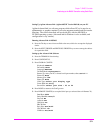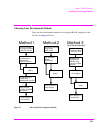
367
Chapter 7, IBASIC Controller
Interfacing to the IBASIC Controller using Serial Ports
PC Configuration
To prepare for IBASIC program development, the external PC or terminal must be
configured to operate with the Test Set. This configuration includes
• Hardware
• Terminal Emulator Software
PC Serial Port Configuration
Refer to Figure 26 on page 364 for connection details. Connect the Test Set’s Serial
Port 9 to a serial I/O (input/output) port on the PC. On many PCs, a serial port is
available as either a 25-pin DB-25 (female) connector or a 9-pin DB-9 (male)
connector. This port can be configured as COM1, COM2, COM3, or COM4
(communications port 1, 2, 3, or 4) depending on the installed PC hardware and
user-defined setup. Refer to the instructions shipped with the PC for hardware and
software configuration information.
Terminal Emulator Configuration Information
A “terminal emulator” is an application program running on the PC that
communicates with one of the serial communication ports installed in the PC. It
provides a bi-directional means of sending and receiving ASCII characters to the
Test Set’s serial port.
In general, a “terminal emulator” enables the PC to act like a dedicated computer
terminal. This type of terminal was used before PCs to allow remote users to
communicate through RS232 with central mainframe computers. An ANSI-
compatible terminal like the Digital Equipment Corporation VT-100 can be used
to directly communicate with the Test Set. PC terminal emulation application
programs have been designed to have setup fields much like these older
technology terminals.


















